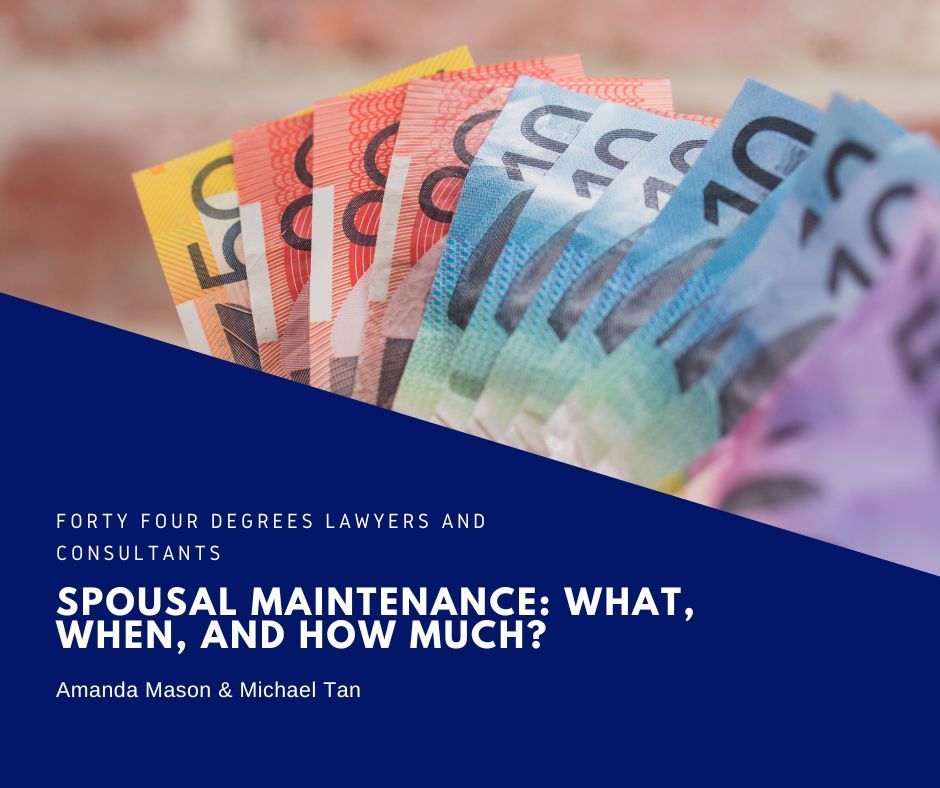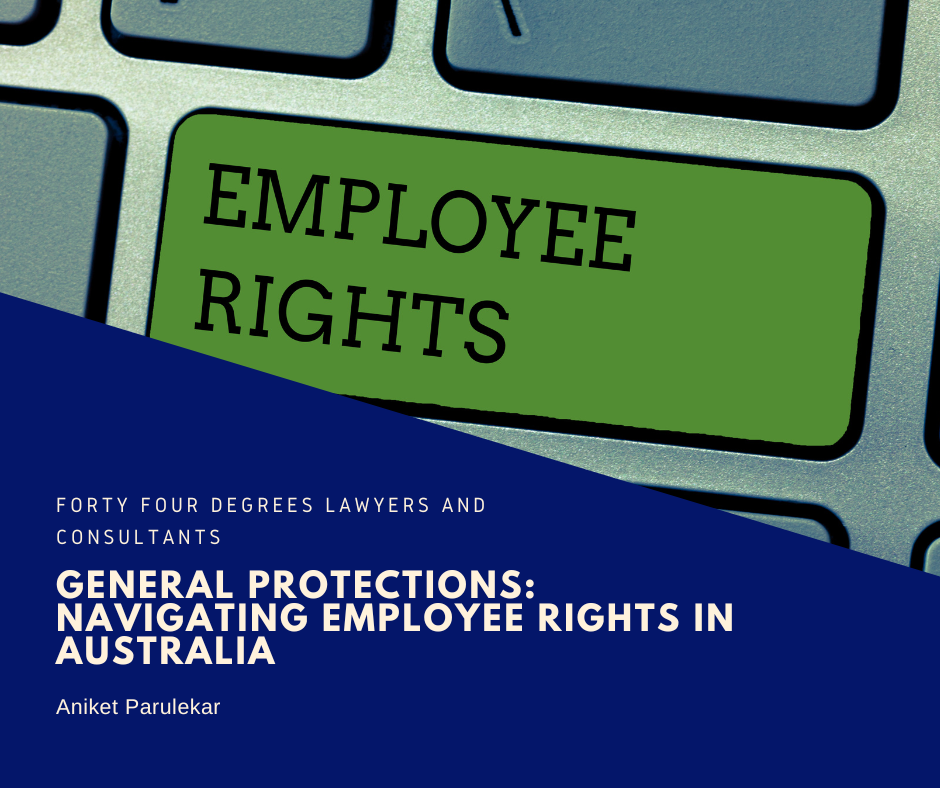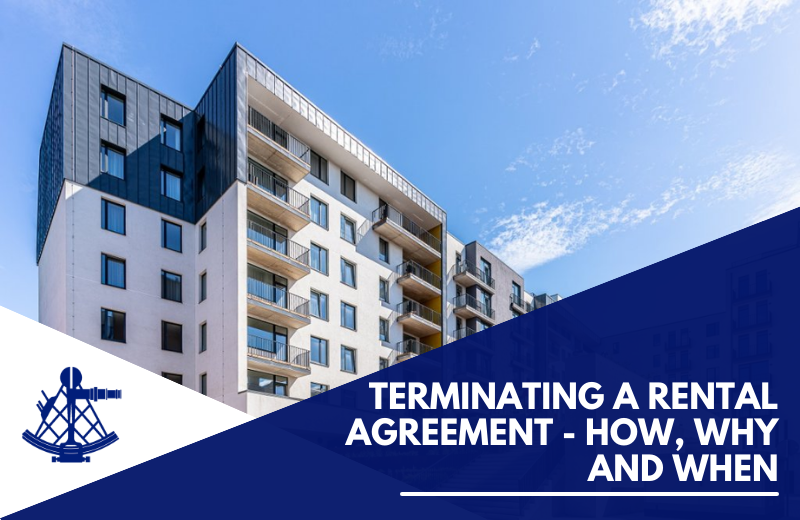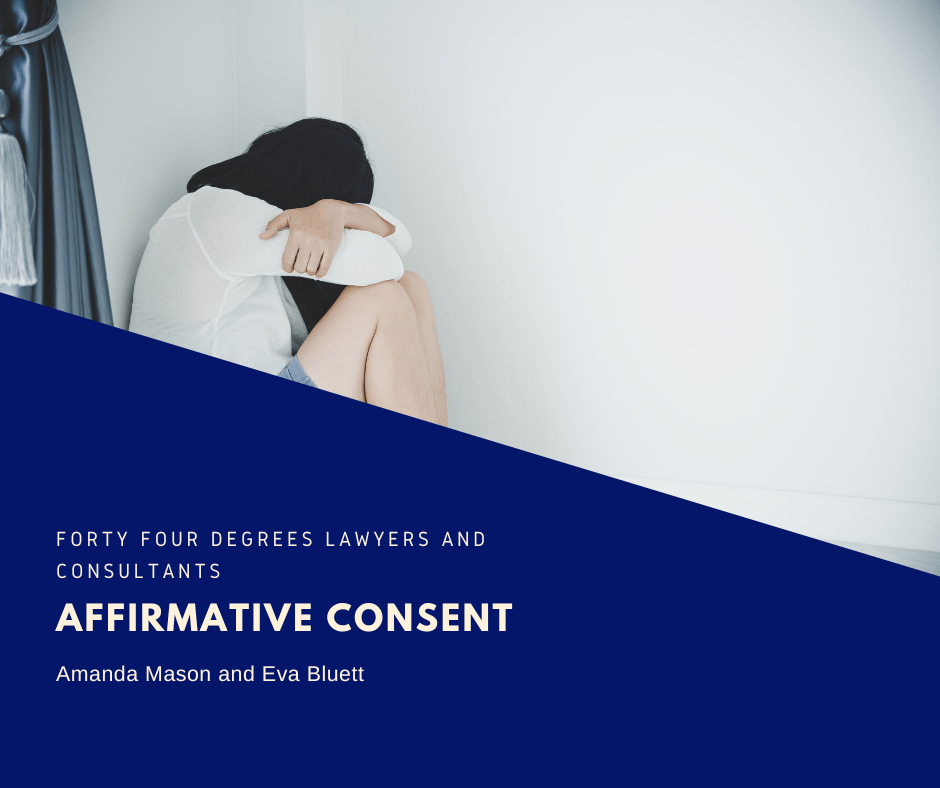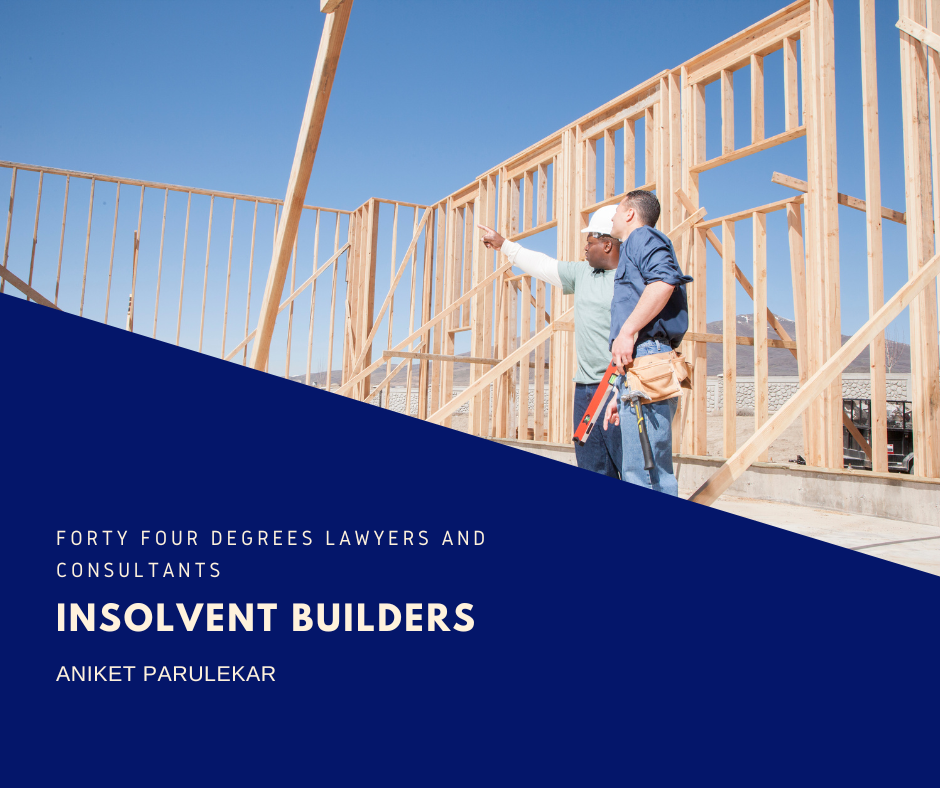Owner-Builder Works: Certification, obligations and becoming a vendor
Recently, Henry McMenomy was invited to present at a seminar hosted by the Australia Institute of Conveyers on the various obligations and penalties that apply to owner-builder works.
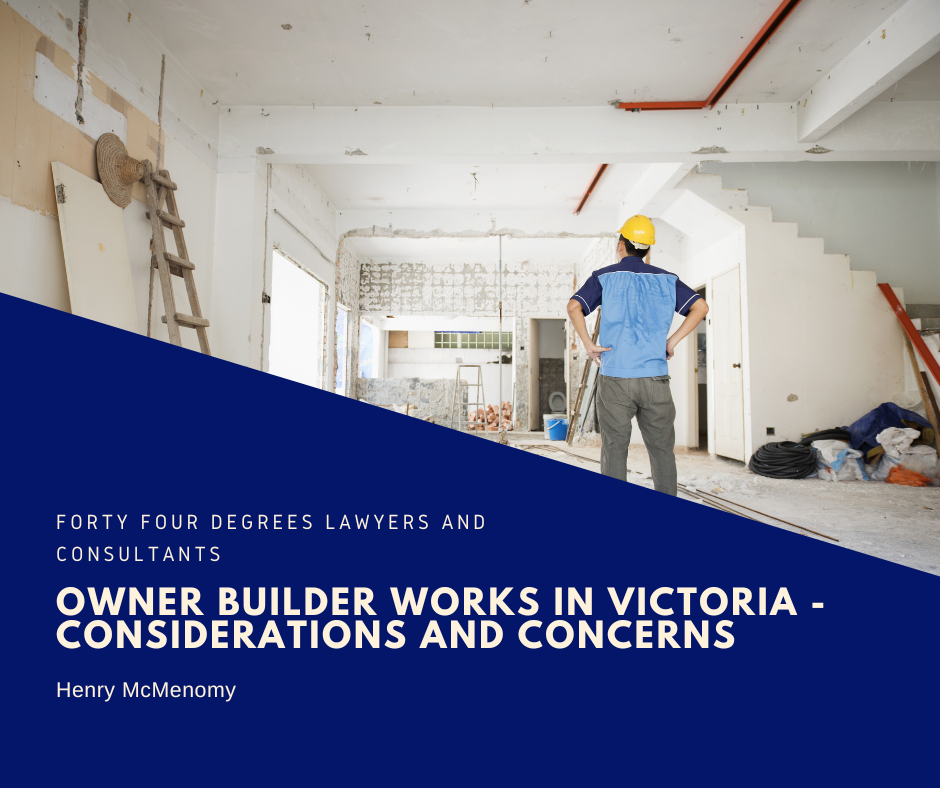
What is an owner-builder?
The Victorian Building Authority (VBA) defines an owner-builder as ‘someone who takes responsibility for domestic building work carried out on their own land.’ Domestic building work carries a broad definition, encompassing constructing new dwellings, alterations, renovations and additions to existing dwellings, ancillary buildings, and structures.
Owner-builder work includes where the owner intends to carry out part of the work themselves and contract out other aspects of the work, but not circumstances where all work is contracted out to a single tradesperson.
Certificate of Consent
An owner-builder who wishes to carry out work in excess of $16,000 (including the cost of materials and labor), must first obtain a certificate of consent from the Victorian Building Authority. To be eligible, the applicant must:
- Be the owner of the land;
- Intend to perform work in relation to a single domestic dwelling;
- Reside or intend to reside at the dwelling;
- Not be in the ‘business of building’; and
- Complete an owner-builder eLearning assessment.
Applicants are excluded if they have previously entered into a contract to sell an owner-built home without the relevant insurance or have been issued an owner-builder permit in the previous 5 years for a different property. However, exceptions may be granted in special circumstances.
What are your responsibilities as an owner-builder?
Owner-builders need to be aware that they are also taking on a range of responsibilities and legal obligations, including:
- Doing all or part of the work yourself, except for work required to be carried out by licensed tradespeople (noting that owner-builders are not permitted to carry out demolition, subfloor works or relocate homes);
- Entering a major domestic building contract when required;
- Ensuring contracted tradespeople are registered and licenced as required;
- Engaging a building surveyor to issue building permits, conduct building inspections and issue an occupancy permit (for a new building) or a certificate of final inspection (for renovations) upon completion of works;
- Supervising building work and maintaining occupational health and safety for workers; and
- Ensuring building works comply with the relevant Australian standards, set out in the National Construction Code.
When is a major domestic building contract required?
Where the costs of works exceed $10,000, involve structural work, or involve two or more trades, owner-builders are prohibited from completing the work themselves. Rather, they must enter a major domestic building contract with a building practitioner registered under the Building Act 1993. Importantly, the $10,000 threshold for works will apply even if the contract has been split into several smaller amounts, such as contracts divided into pre-construction and construction.
Owner-builder dispute resolution
Typically, where a dispute arises over domestic building works between a homeowner and a builder, sub-contractor, architect or engineer, the parties are required to engage in a range of steps before they are permitted to escalate their claim to the Victorian Civil and Administrative Tribunal (VCAT).
First, the parties must attempt to resolve the dispute between themselves, or at least make multiple attempts to contact the other party to do so. Subsequently, the parties will need to follow the dispute resolution procedure outlined by Domestic Building Dispute Resolution Victoria (DBDRV). Initially, DBDRV will make an assessment as to whether the dispute is appropriate for their free conciliation process. If the matter is deemed appropriate, DBDRV may request a building assessment of the disputed works for the purpose of narrowing the issues in dispute.
Following any building assessment that might be conducted, the parties must attempt to resolve their dispute through conciliation run by DBDRV. If a settlement is reached, the parties will be issued a formal record of agreement. Otherwise, DBDRV will issue a certificate of conciliation or a binding dispute resolution, depending on whether a partial remedy is appropriate. It is only where the matter is not completely resolved that the parties will be permitted to escalate their dispute to VCAT.
However, an exception to the DBDRV dispute resolution process may apply where a homeowner has entered a contract with one party for one type of work, and that work relates to plumbing, painting, plastering, tiling, insulating, glazing, installing floor coverings, attaching external fixtures, electrical work, or fencing (that does not require a permit). In these circumstances, parties may be permitted to progress their dispute directly to VCAT.
Parties to a building dispute should be aware that there are pros and cons to both the DBDRV dispute resolution process and VCAT and seek careful legal advice on their options and circumstances prior to escalating any dispute.
Selling the property
It is important that both owner-builders, and parties to the sale of property are aware of the obligations imposed on owner-builder works under section 137B of the Building Act. Under section 137B, a person who constructs a building must not enter a contract for the sale of that building within the prescribed period unless certain conditions have been complied with.
What is the prescribed period?
Where an occupancy permit or certificate of final inspection has been issued confirming the completion of works, the prescribed period is 6 years and 6 months from the completion of work. If such permit or certificate has not been issued, the relevant period is 7 years from the issue of the building permit or 6 year and 6 months from the certified date of commencement of work.
Insurance requirements
Where domestic building works have been carried out in excess of $16,000, the owner-builder must obtain Domestic Building Insurance before selling the property and provide a certificate of the insurance to the purchaser. This insurance is designed to protect purchasers from circumstances where the owner-builder dies, becomes insolvent or can’t be located after a defect arises. Domestic Building Insurance provides cover of up to $300,000 for both structural and non-structural defects. However, the period of cover varies depending on the nature of the defect. While structural defects are covered for a period of 6 years from either the completion of work or the date of termination of the building contract (whichever is earlier), non-structural defects are covered for a period of just 2 years. The distinction between structural and non-structural defects is outlined in Ministerial Orders which accompany the Building Act.
Defects report requirement
Section 137B also imposes obligations on owner-builders to obtain a defects report from a prescribed practitioner (such as a building surveyor or endorsed building engineer) for all owner-builder work, regardless of the value, within 6 months prior to entering into a contract for sale of the building.
Prescribed warranties
Owner-builder vendors are also required to provide a list of warranties to purchasers in a contract for sale of a home. These warranties include assurances to the effect:
- That all domestic building work carried out in relation to the construction by, or on behalf of the vendor was carried out in a proper and workmanlike manner;
- That all materials used in that domestic building work were good and suitable for the purpose for which they were used and that, unless otherwise stated, those materials were new; and
- That the domestic building work was carried out in accordance with all laws and legal requirements.
Consequences of a failure to comply
A failure by an owner-builder vendor to comply with these requirements can result in serious consequences for the vendor. Importantly, where an owner-builder vendor fails to comply with any of the applicable requirements before the purchaser enters into the contract of sale, the purchaser is permitted to void the contact at any point prior to settlement. Further, these requirements cannot be contracted out of. Once the vendor is in breach of these requirements, there is little they can do to prevent a purchaser from voiding the contract prior to settlement.
As a purchaser, it is important that due diligence is conducted prior to settlement to identify any owner-builder works that may have been completed on the property, whether or not they were conducted by the vendor during the prescribed time.
The public register of Certificates of Consent on the Victorian Building Authority’s website (found here) can be useful for identifying potential owner builder works that have been carried out since 2016, noting that information will only remain listed for 10 years.
Failure to comply with the requirements of section 137B is an offence punishable by a fine of 100 penalty units (currently $18,492.00). Additionally, practitioners acting for either vendors or purchaser may face their own professional liability if they have failed to adequately advise their clients on the potential consequences of owner-builder works and section 137B.
Guidance for Purchasers
Before signing
Prior to settlement, it is important that purchasers receive sufficient advice on their rights with respect to owner-builder works and the obligations imposed by section 137B.
In addition to conducting due diligence of the standard section 32 requirements, purchasers should also instruct their advising conveyancer or solicitor to review the public register of Certificates of Consent, enquire directly with the vendor about owner-builder works and any of the abovementioned s 137B requirements, and ensure that the contract is subject to the typical building and pest reports.
Further, because poorly completed building works can negatively impact adjoining properties, careful consideration should be made as to whether any works can be identified on neighboring properties that may cause unforeseen negative consequences.
Purchasers should also be aware that owner-builder works may not be identified in building permits. A review of building permits should merely be a starting point to owner-builder works due diligence.
After signing
While purchasers in Victoria might be comforted by the 3-day cooling off period that sometimes applies to sales of land under the Sale of Land Act 1962, this should not be presumed as a sufficient failsafe against shoddy or uninsured owner-builder works that may come to light. Further, because of the prevalence of property sales by public auction, many contracts will not have this protection at all.
Instead, purchasers should prioritise any due diligence that may not have been completed prior to signing. If the contract is subject to a building report and a major building defect is identified, the contract may be voided by providing the report and notice of termination within 14 days of the date of sale. If a defect is discovered that was not identified in the report, the purchaser may have a claim against the vendor or registered domestic builder for breach of the required statutory warranties.
Finally, if a purchaser identifies owner-builder works that have not met the requirements imposed on vendors by section 137B, they should immediately seek legal advice as to whether they should exercise their right to void the contract prior to settlement.
It is vital for conveyancers and solicitors acting for both purchasers and vendors to be aware of the numerous responsibilities, risks, liabilities, and potential penalties imposed on owner-builders and parties to the sale of property. Careful consideration and enquiries should be made with not only the other party in the sale of property, but all permits, reports and external databases that are available.
Should you require assistance or further information in relation to the above, please contact Henry McMenomy, Solicitor, at [email protected] or Nicola Drakeford, Partner, at [email protected].
Contact Us
We’re an Australian Law Firm promoting a nuanced, personal touch. We have the skills you need to resolve your case quickly and with a positive outcome. Our straight talking team stays close to simplify what is most often a complicated process. We help individuals and businesses with technology and startup law, property law including conveyancing and leasing, commercial law, civil litigation, wills, estates, bankruptcy, insolvency, criminal law, and professionals facing investigations and charges from their regulatory body.
We have a connected network of talented lawyers in Melbourne CBD, Dandenong, Ballarat, and Ivanhoe East.
Fill out the form or call us on 1300 892 237.
We will get back to you as soon as possible
Oops, there was an error sending your message.
Please try again later or call us on 1300 892 237.




